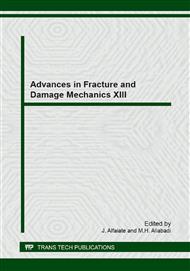[1]
A. Riccio, A. Raimondo and F. Scaramuzzino. A study on skin delaminations growth in stiffened composite panels by a novel numerical approach. Appl. Comp. Mat. 2013;20(4):465-488.
DOI: 10.1007/s10443-012-9282-7
Google Scholar
[2]
A. Riccio, F. Scaramuzzino and P. Perugini. Influence of Contact Phenomena on Embedded Delamination Growth in Composites. AIAA Journal 2003;41(5):933-940.
DOI: 10.2514/2.2029
Google Scholar
[3]
A. Riccio, A. Raimondo, S. Fragale, F. Camerlingo, B. Gambino, C. Toscano and D. Tescione. Delaminations buckling and growth phenomena in stiffened composite panels under compression. Part I: an Experimental Study. Journal of Composite Materials 2013;
DOI: 10.1177/0021998313502741
Google Scholar
[4]
A. Riccio, A. Raimondo, F. Di Caprio and F. Scaramuzzino. Delaminations buckling and growth phenomena in stiffened composite panels under compression. Part II: a Numerical Study. Journal of Composite Materials 2013;.
DOI: 10.1177/0021998313502742
Google Scholar
[5]
E. Pietropaoli and A. Riccio. On the robustness of finite element procedures based on Virtual Crack Closure Technique and fail release approach for delamination growth phenomena. Definition and assessment of a novel methodology. Comp. Sci. Tech 2010;70(8):1288-1300.
DOI: 10.1016/j.compscitech.2010.04.006
Google Scholar
[6]
E. Pietropaoli and A. Riccio. Formulation and assessment of an enhanced finite element procedure for the analysis of delamination growth phenomena in composite structures. Composite Science and Technology 2011;71(6):836-846.
DOI: 10.1016/j.compscitech.2011.01.026
Google Scholar
[7]
D.W. Sleight. Progressive failure analysis methodology for laminated composite structures,Technical Report NASA/TP-1999-209107. Hampton, VA: Langley Res. Cent., 1999.
Google Scholar
[8]
I. Lapczyk e J. Hurtado. Progressive damage modeling in fiber-reinforced materials. In: Composites Part-A 38 (2007), p.2333–2341.
DOI: 10.1016/j.compositesa.2007.01.017
Google Scholar
[9]
P.P. Camanho and C.G. Dávila. Mixed-modede cohesion finite elements for the simulation of delamination in composite materials. NASA/TM-2002-211737. 2002, p.1–37.
Google Scholar
[10]
J.F. Chen, E.V. Morozov and k. Shankar A combined elasto-plastic damage model for progressive failure analysis of composite materials and structures. Comp. Struc. 94 (2012), p.3478–3489.
DOI: 10.1016/j.compstruct.2012.04.021
Google Scholar
[11]
Y.S.N. Reddy, C.M.D. Moorthy and J.N. Reddy. Non-linear progressive failure analysis of laminated composite plates. In: Int. J. Non-Linear Mechanics 30.5 (1995), p.629–649.
DOI: 10.1016/0020-7462(94)00041-8
Google Scholar


